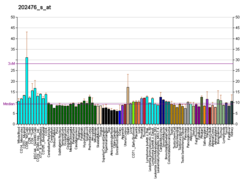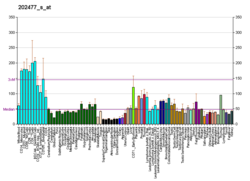| TUBGCP2 |
|---|
|
| Identifiers |
|---|
| Aliases | TUBGCP2, GCP-2, GCP2, Grip103, SPBC97, Spc97p, h103p, hGCP2, hSpc97, tubulin gamma complex associated protein 2, ALP4, SPC97, PAMDDFS |
|---|
| External IDs | OMIM: 617817; MGI: 1921487; HomoloGene: 55980; GeneCards: TUBGCP2; OMA:TUBGCP2 - orthologs |
|---|
| Gene location (Human) |
|---|
 | | Chr. | Chromosome 10 (human)[1] |
|---|
| | Band | 10q26.3 | Start | 133,278,635 bp[1] |
|---|
| End | 133,318,823 bp[1] |
|---|
|
| Gene location (Mouse) |
|---|
 | | Chr. | Chromosome 7 (mouse)[2] |
|---|
| | Band | 7|7 F4 | Start | 139,575,868 bp[2] |
|---|
| End | 139,616,582 bp[2] |
|---|
|
| RNA expression pattern |
|---|
| Bgee | | Human | Mouse (ortholog) |
|---|
| Top expressed in | - right uterine tube
- skin of abdomen
- anterior pituitary
- right lobe of thyroid gland
- left lobe of thyroid gland
- left uterine tube
- spleen
- right lung
- canal of the cervix
- tibial nerve
|
| | Top expressed in | - spermatocyte
- seminiferous tubule
- maxillary prominence
- spermatid
- somite
- autopod region
- hand
- dermis
- foot
- abdominal wall
|
| | More reference expression data |
|
|---|
| BioGPS | 
 | | More reference expression data |
|
|---|
|
| Gene ontology |
|---|
| Molecular function | - structural constituent of cytoskeleton
- protein binding
- microtubule minus-end binding
- gamma-tubulin binding
| | Cellular component | - cytoplasm
- cytosol
- centrosome
- spindle pole
- equatorial microtubule organizing center
- membrane
- nucleoplasm
- microtubule organizing center
- gamma-tubulin small complex
- spindle pole body
- cytoplasmic microtubule
- cytoskeleton
- microtubule
- gamma-tubulin complex
| | Biological process | - centrosome duplication
- microtubule nucleation by interphase microtubule organizing center
- mitotic spindle assembly
- cytoplasmic microtubule organization
- microtubule cytoskeleton organization
- microtubule nucleation
- meiosis
- mitotic cell cycle
- spindle assembly
- protein-containing complex assembly
| | Sources:Amigo / QuickGO |
|
| Orthologs |
|---|
| Species | Human | Mouse |
|---|
| Entrez | | |
|---|
| Ensembl | | |
|---|
| UniProt | | |
|---|
| RefSeq (mRNA) | |
|---|
NM_001256617
NM_001256618
NM_006659 |
| |
|---|
NM_001286007
NM_001286009
NM_001286011
NM_133755 |
|
|---|
| RefSeq (protein) | |
|---|
NP_001243546
NP_001243547
NP_006650 |
| |
|---|
NP_001272936
NP_001272938
NP_001272940
NP_598516 |
|
|---|
| Location (UCSC) | Chr 10: 133.28 – 133.32 Mb | Chr 7: 139.58 – 139.62 Mb |
|---|
| PubMed search | [3] | [4] |
|---|
|
| Wikidata |
| View/Edit Human | View/Edit Mouse |
|



















